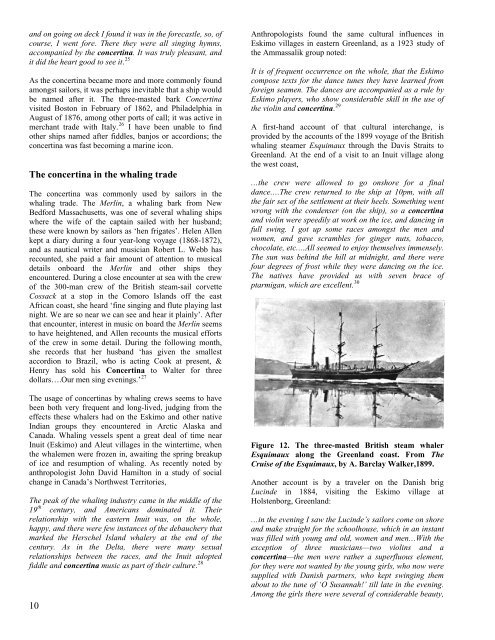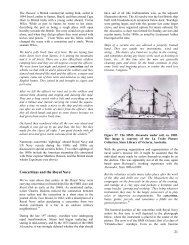The Concertina at Sea - The Anglo-German Concertina
The Concertina at Sea - The Anglo-German Concertina
The Concertina at Sea - The Anglo-German Concertina
Create successful ePaper yourself
Turn your PDF publications into a flip-book with our unique Google optimized e-Paper software.
and on going on deck I found it was in the forecastle, so, of<br />
course, I went fore. <strong>The</strong>re they were all singing hymns,<br />
accompanied<br />
by the concertina. It was truly pleasant, and<br />
it did the heart good to see it. 25<br />
As the concertina became more and more commonly found<br />
amongst sailors, it was perhaps inevitable th<strong>at</strong> a ship would<br />
be named after it. <strong>The</strong> three-masted bark <strong>Concertina</strong><br />
visited Boston in February of 1862, and Philadelphia in<br />
August of 1876, among other ports of call; it was active in<br />
merchant trade with Italy. able to find<br />
ther ships named after fiddles, banjos or accordions; the<br />
oncertina was fast becoming a marine icon.<br />
26 I have been un<br />
o<br />
c<br />
<strong>The</strong> concertina in the whaling trade<br />
<strong>The</strong> concertina was commonly used by sailors in the<br />
whaling trade. <strong>The</strong> Merlin, a whaling bark from New<br />
Bedford Massachusetts, was one of several whaling ships<br />
where the wife of the captain sailed with her husband;<br />
these were known by sailors as ‘hen frig<strong>at</strong>es’. Helen Allen<br />
kept a diary during a four year-long voyage (1868-1872),<br />
and as nautical writer and musician Robert L. Webb has<br />
recounted, she paid a fair amount of <strong>at</strong>tention to musical<br />
details onboard the Merlin and other ships they<br />
encountered. During a close encounter <strong>at</strong> sea with the crew<br />
of the 300-man crew of the British steam-sail corvette<br />
Cossack <strong>at</strong> a stop in the Comoro Islands off the east<br />
African coast, she heard ‘fine singing and flute playing last<br />
night. We are so near we can see and hear it plainly’. After<br />
th<strong>at</strong> encounter, interest in music on board the Merlin seems<br />
to have heightened, and Allen recounts the musical efforts<br />
of the crew in some detail. During the following month,<br />
she records th<strong>at</strong> her husband ‘has given the smallest<br />
accordion to Brazil, who is acting Cook <strong>at</strong> present, &<br />
Henry<br />
has sold his <strong>Concertina</strong> to Walter for three<br />
dollars….Our men sing evenings.’ 27<br />
<strong>The</strong> usage of concertinas by whaling crews seems to have<br />
been both very frequent and long-lived, judging from the<br />
effects these whalers had on the Eskimo and other n<strong>at</strong>ive<br />
Indian groups they encountered in Arctic Alaska and<br />
Canada. Whaling vessels spent a gre<strong>at</strong> deal of time near<br />
Inuit (Eskimo) and Aleut villages in the wintertime, when<br />
the whalemen were frozen in, awaiting the spring breakup<br />
of ice and resumption of whaling. As recently<br />
noted by<br />
anthropologist<br />
John David Hamilton in a study of social<br />
change in Canada’s Northwest Territories,<br />
<strong>The</strong> peak of the whaling industry came in the middle of the<br />
19<br />
xual<br />
l<strong>at</strong>ionships between the races, and the Inuit adopted<br />
th century, and Americans domin<strong>at</strong>ed it. <strong>The</strong>ir<br />
rel<strong>at</strong>ionship with the eastern Inuit was, on the whole,<br />
happy, and there were few instances of the debauchery th<strong>at</strong><br />
marked the Herschel Island whalery <strong>at</strong> the end of the<br />
century. As in the Delta, there were many se<br />
re<br />
fiddle and concertina music as part of their culture. 28<br />
10<br />
Anthropologists found the same cultural influences in<br />
Eskimo villages in eastern Greenland, as a 1923 study of<br />
the Ammassalik group noted:<br />
It is of frequent occurrence on the whole, th<strong>at</strong> the Eskimo<br />
compose<br />
texts for the dance tunes they have learned from<br />
foreign seamen. <strong>The</strong> dances are accompanied as a rule by<br />
Eskimo players, who show considerable skill in the use of<br />
the violin and concertina. 29<br />
A first-hand account of th<strong>at</strong> cultural interchange, is<br />
provided<br />
by the accounts of the 1899 voyage of the British<br />
whaling steamer Esquimaux through the Davis Straits to<br />
Greenland. At the end of a visit to an Inuit village along<br />
the west coast,<br />
y themselves immensely.<br />
he sun was behind the hill <strong>at</strong> midnight, and there were<br />
four degrees of frost while they were dancing on the ice.<br />
<strong>The</strong> n<strong>at</strong>ives have provided us with seven brace of<br />
ptarmigan, which are excellent. 30<br />
…the crew were allowed to go onshore for a final<br />
dance….<strong>The</strong> crew returned to the ship <strong>at</strong> 10pm, with all<br />
the fair sex of the settlement <strong>at</strong> their heels. Something went<br />
wrong with the condenser (on the ship), so a concertina<br />
and violin were speedily <strong>at</strong> work on the ice, and dancing in<br />
full swing. I got up some races amongst the men and<br />
women, and gave scrambles for ginger nuts, tobacco,<br />
chocol<strong>at</strong>e, etc….All seemed to enjo<br />
T<br />
Figure 12. <strong>The</strong> three-masted British steam whaler<br />
Esquimaux along the Greenland coast. From <strong>The</strong><br />
Cruise of the Esquimaux, by A. Barclay Walker,1899.<br />
Another account is by a traveler on the Danish brig<br />
Lucinde in 1884, visiting the Eskimo village <strong>at</strong><br />
Holstenborg, Greenland:<br />
…in the evening I saw the Lucinde’s sailors come on shore<br />
and make straight for the schoolhouse, which in an instant<br />
was filled with young and old, women and men…With the<br />
exception of three musicians—two violins and a<br />
concertina—the men were r<strong>at</strong>her a superfluous element,<br />
for they were not wanted by the young girls, who now were<br />
supplied with Danish partners, who kept swinging them<br />
about to the tune<br />
of ‘O Susannah!’ till l<strong>at</strong>e in the evening.<br />
Among<br />
the girls there were several of considerable beauty,




